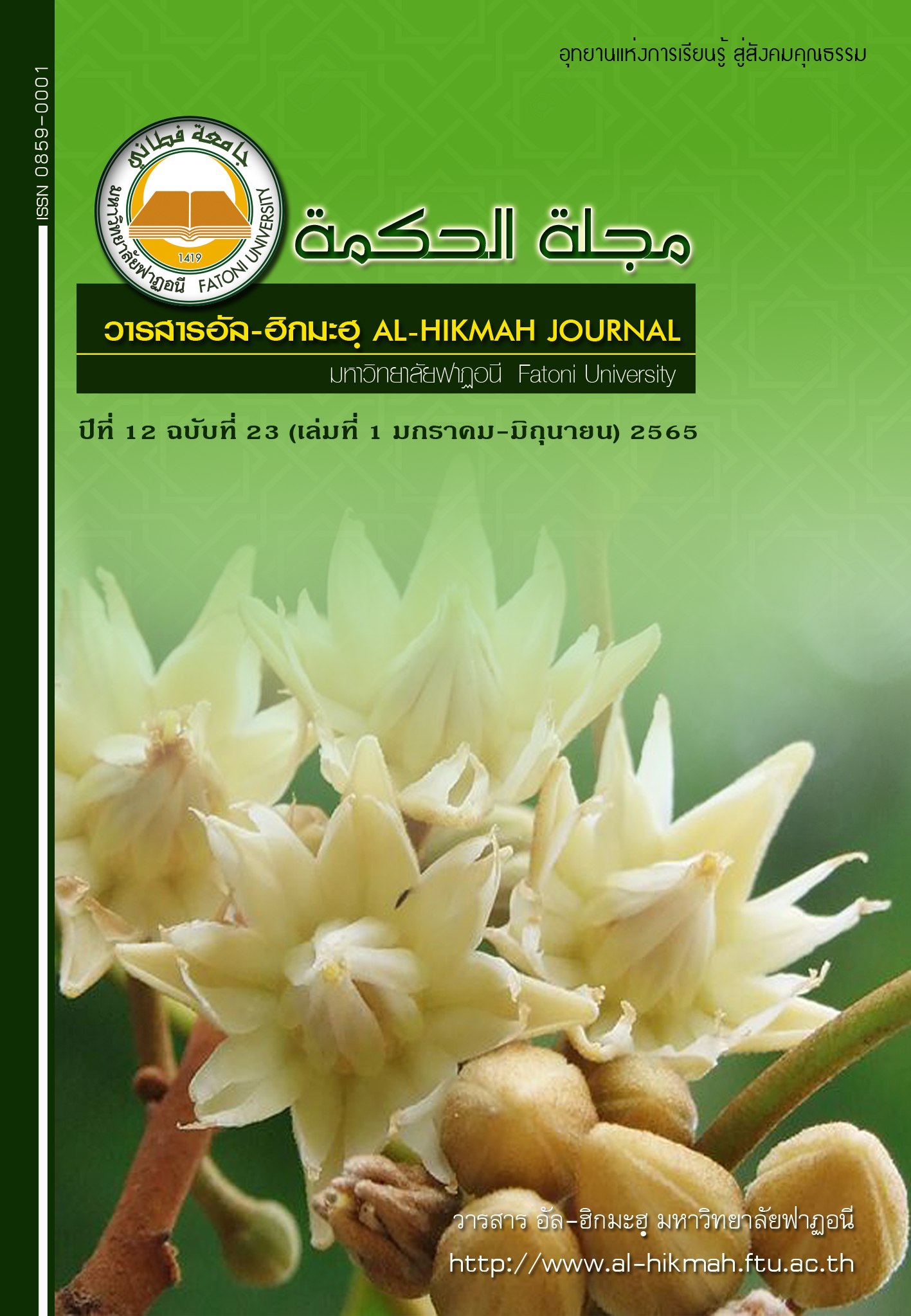การจัดการห่วงโซ่คุณค่าการเลี้ยงไก่เบตงเพื่อลดความยากจนในพื้นที่สามจังหวัดชายแดนใต้
Abstract
This action research aimed to investigate the management implemented on Betong’s chicken value chain for Deep South’s poverty reduction upstream, midstream, and downstream. Data were collected from questionnaires and semi-structured interviews with purposively selected 175 households classified as in-poverty. The data were further analyzed by descriptive statistics and a content analysis. Results revealed that the researcher supplied five pure Betong chicken breeds aged 30-45 days and 45 kilograms of chicken feed per household and organized short-term training on Betong chicken farming as upstream interventions. The midstream intervention was conducted in two phases. In Phase 1, the households in poverty were assessed to determine their capacities in raising Betong chickens by applying knowledge obtained from the training into practice. Consequently, 100 households passed the assessment as Betong chickens had a survival rate of 40%. In Phase 2, the households were required to raise 15 Betong chickens as an occupation while receiving support for chicken house equipment and 135 kilograms of chicken feed. As a result, 93.67% of Betong chickens survived while these households earned increased revenues averaging 3,075 baht. For the downstream intervention, the researcher discussed an idea of market expansion with business operators to negotiate for a sale of Betong chickens at the price range of 100-110 baht per kilogram to help Deep South households generate higher revenues.
References
กรมพัฒนาชุมชน. (2561). แผนปฏิบัติราชการกรมการพัฒนาชุม 4 ปี พ.ศ.2561-2564 [ออนไลน์]. สืบค้นเมื่อ 10 ตุลาคม 2563, จาก : http://www.oic.go.th/FILEWEB/CABINFOCENTER20/DRAWER093/GENERAL/DATA0000/0 0000154.PDF
กลุ่มยุทธศาสตร์การพัฒนาภาคใต้ชายแดน. (2561). แผนพัฒนากลุ่มจังหวัดภาคใต้ชายแดน พ.ศ. 2561 - 2565(ฉบับทบทวน) [ออนไลน์]. สืบค้นเมื่อ 22 พฤษภาคม 2563, จาก : https://www.osmsouth-border.go.th/files/com_news_develop/2021-04_92093815cf0a8c8.pdf
ขนิษฐา คงรักเกียรติยศ. (2563). อัตราความยากจนของประเทศไทยเพิ่มสูงขึ้นท่ามกลางเศรษฐกิจที่ชะลอตัว [ออนไลน์]. สืบค้นเมื่อ 06 มิถุนายน 2562, จาก : https://www.worldbank.org/th/news/press-release/2020/03/03/thailands-poverty-on-the-rise-amid-slowing-economic-growth
ทวี มีเงิน. (2562). ทำไม “สี จิ้น ผิง” แก้ความยากจนได้ผล. [ออนไลน์]. สืบค้นเมื่อวันที่ 03 กุมภาพันธ์ 2562, จาก : https://www.businesstoday.co/opinions/27/10/2019/10308/
ธนพล สราญจิตร์. (2558). ปัญหาความยากจนในสังคมไทย. วารสารวิชาการมหาวิทยาลัยอีสเทิร์นเอเชีย ฉบับสังคมศาสตร์และมนุษยศาสตร์, 5(2), 12-21.
ปิยะนันท์ นวลหนูปล้อง. ไชยวรรณ วัฒนจันทร์. สุธา วัฒนสิทธิ์.และบัญชา สมบูรณ์สุข. (2558) เรื่อง ระบบการผลิตไก่เบตงเชิงพาณิชย์ของเกษตรกรในพื้นที่ 3 จังหวัดชายแดนใต้ (ปัตตานี ยะลา และ นราธิวาส) .วารสารวิจัยและส่งเสริมวิชาการเกษตร, 36(1), 11-20.
เพชร ชัยศร. (2556). รูปแบบและกระบวนการลดภาวะความยากจนของผู้เข้าไม่ถึงโอกาส ในสังคมชนบท ภาคเหนือตอนบน. วารสารวิทยาการจัดการ มหาวิทยาลัยราชภัฏเชียงราย, 8(2), 121-141.
มายือนิง อิสอ. (2561). ปัญหาความเหลื่อมล้ำในสถานการณ์วิกฤต : กรณีศึกษาสามจังหวัดชายแดนภาคใต้. สถาบันวิจัยเพื่อการพัฒนาประเทศไทย : กรุงเทพฯ.
ยรรยง ศรีสม. (2553). ห่วงโซ่คุณค่า (ตอนจบ) value chain ในงานโลจิสติกส์.วารสารวิชาการ สมาคมส่งเสริมเทคโนโลยี (ไทย-ญี่ปุ่น) , 37(211), 39-44.
วิสุทธิ บุญญะโสภิต. (2556). แซมาอึล อุนดง: โมเดลสร้างชุมชนเข้มแข็งของเกาหลีใต้ [ออนไลน์]. สืบค้นเมื่อ สืบค้นเมื่อ 03 กุมภาพันธ์ 2562, จาก : http://bwisutttoto.blogspot.com/2013/11/blog-post_15.html
ศุภวัฒน์ เสาเงิน (2560) .ปัจจัยแห่งความสำเร็จในการเป็นหมู่บ้านเป็นหมู่บ้านเศรษฐกิจพอเพียงของบ้านหนองรี ตำบลหนองรี อำเภอเมืองชลบุรี จังหวัดชลบุรี. วิทยานิพนธ์ รัฐประศาสนศาสตรมหาบัณฑิต. วิทยาลัยการบริหารรัฐกิจมหาวิทยาลัยบูรพา.
สำนักงานสภาพัฒนาการเศรษฐกิจและสังคมแห่งชาติ. (2564). ผลิตภัณฑ์มวลรวมในประเทศ ไตรมาสที่ 3/2564 [ออนไลน์]. สืบค้นเมื่อ 01 กุมภาพันธ์ 2565, จาก : https://www.nesdc.go.th/ewt_dl_link.php?nid=5176&filename=QGDP_report
Creswell, J. W., & Plano Clark, V. L. (2018). Designing and conducting mixed methods research. (3nd ed). Thousand Oaks, United States: SAGE Publications Inc.
Porter, M. E. (1985). Competitive Advantage: Creating and Sustainting Superior Performance. New Jersey: Free Press.
Downloads
Published
How to Cite
Issue
Section
License
Copyright (c) 2022 Al-HIKMAH Journal

This work is licensed under a Creative Commons Attribution-NonCommercial-NoDerivatives 4.0 International License.



